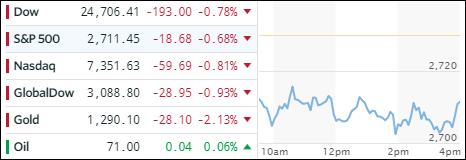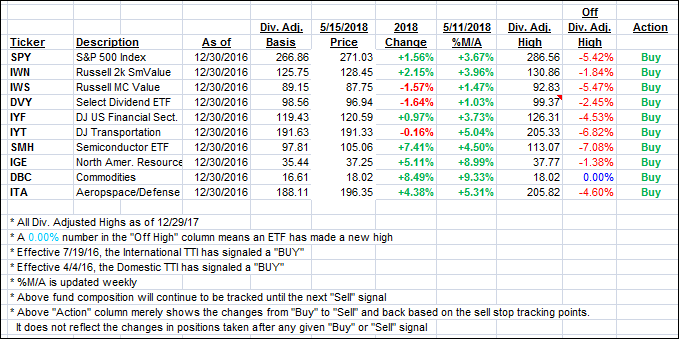- Moving the markets
It all started with an April slowdown in retail sales from a revised higher (+0.8%) March number to a lame +0.3% in April indicating a lack of follow through growth. That sent equities lower right after the opening to a level at which the indexes vacillated till closing with the Dow and Transports dipping into the red YTD.
The VIX had its own wild ride by dropping early to the 12 handle only to rebound sharply to touch the 15 number, a rally that kept the indexes pinned below their respective unchanged lines. Remember, a rising VIX causes lower stock prices and vice versa.
But the bloodbath occurred in Treasury Bonds with the yield on the 10-year spiking 8 basis points to an intra-day high of 3.09% but settling at 3.08%, it’s highest since 2011 and its largest single-day jump since March. That punished bond prices with the 20-year (TLT) gapping down and losing -1.14%.
This jump in yield came among continued worries about the uncertainty caused by the deadlock of trade negotiations between the U.S. and China. The fear remains that a clash, or no resolution, may push prices and inflation higher affecting bonds negatively.
It now remains to be seen if the recent channel breakout of the S&P was head fake, which I believe could be true, especially if interest rates continue their path higher. If they retreat, we might see a resumption of the recent trend line bounce.
- ETFs in the Spotlight
In case you missed the announcement and description of this section, you can read it here again.
It features 10 broadly diversified and sector ETFs from my HighVolume list as posted every Saturday. Furthermore, they are screened for the lowest MaxDD% number meaning they have been showing better resistance to temporary sell offs than all others over the past year.
The below table simply demonstrates the magnitude with which some of the ETFs are fluctuating in regards to their positions above or below their respective individual trend lines (%M/A). A break below, represented by a negative number, shows weakness, while a break above, represented by a positive percentage, shows strength.
For hundreds of ETF choices, be sure to reference Thursday’s StatSheet.
Year to date, here’s how our candidates have fared so far:
Again, the %M/A column above shows the position of the various ETFs in relation to their respective long term trend lines, while the trailing sell stops are being tracked in the “Off High” column. The “Action” column will signal a “Sell” once the -7.5% point has been taken out in the “Off High” column.
- Trend Tracking Indexes (TTIs)
Our Trend Tracking Indexes (TTIs) headed south as the bears were in charge of this session.
Here’s how we closed 05/15/2018:
Domestic TTI: +1.78% above its M/A (last close +2.05%)—Buy signal effective 4/4/2016
International TTI: +2.39% below its M/A (last close +2.93%)—Buy signal effective 7/19/2016
Disclosure: I am obliged to inform you that I, as well as my advisory clients, own some of the ETFs listed in the above table. Furthermore, they do not represent a specific investment recommendation for you, they merely show which ETFs from the universe I track are falling within the guidelines specified.
Contact Ulli

